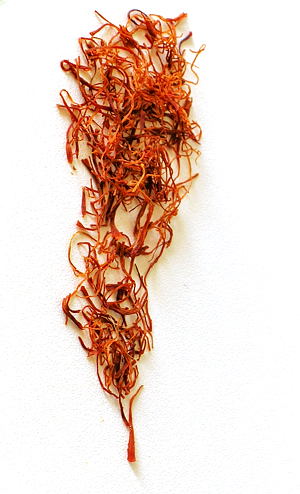
The majestic Saffron is one spice that rightfully deserves our respect. The number of hours spent plucking the saffron flowers and then the stigmas is just mind blowing. Something like 50,000 flowers, a football field-sized patch, must be grown to produce just one pound of saffron.
Saffron is the stigma of crocus flower, so the botanical name Crocus sativus. Harvest season lasts for 2 weeks and the flowers are picked each morning. The 3 stigmas in each blossom are hand-picked. After plucking, the stigmas are light roasted which dries the stigmas and fixes the flavor in the threads. This delicate stage of roasting is done only by the most expert of farmers. Even as little as a minute too long on the fire and the whole batch would be ruined.
The saffron crocus is sterile and the crop is propagated by corm multiplication. Each corm lasts only for one season and then is replaced by up to 10 cormlets. The size of the corm has a very significant effect on the production of daughter corms, and on the production of flowers and the yield of saffron. Saffron flower is amazingly beautiful and fragrant. It has pale lilac petals with dark colored veins. Saffron crop can tolerate frosts and an occasional snow. It grows in a wide range of soils but thrives in clay-calcareous soil.
Saffron is used in Ayurveda as a good heart tonic for all three doshas, and is also an important ingredient in many Ayurvedic medicines. For example, “Shatavari Plus” has saffron as one of its main ingredients. Saffron has circulatory stimulant properties, is warming and very rejuvenating. Saffron milk is an excellent remedy for Anemia. It is also known to tonify the female reproductive system. The cosmetics industry uses saffron in lotions and creams for its ability to nourish and lighten the skin.
And, of course, we all are familiar with the bright golden yellow Saffron robes of Buddhist monks. The color of their robes speaks volumes of their renunciation. When a young green leaf turns yellow or orange, it falls off from the tree. The Buddhist monks wear yellow saffron robes to constantly remind them to let go and not cling to the earthly pleasures.
Since Saffron and Kashmir are inseparable and I am such a big tea fan, we have to have a cup of Kahva (Kashmiri chai with saffron). This tea is amazingly aromatic and an experience in itself. Here is a very good post on Kahva. Note that this Kahva is different from Kava, a herbal drink from south Pacific.
A classic and simple dessert with Saffron is Shrikhand.
Classic Shrikhand with Saffron:
1-cup whole milk yogurt
1-cup sugar
Saffron – 1 teaspoon, or to your liking
Charoli (chironji) – 1 tablespoon, or to taste
Crushed cardamom seeds – ¼ teaspoon
Tie yogurt in a clean muslin cloth. Keep in a sieve and place a heavy pan over it. Keep overnight to drain all water. Once all water is drained from the yogurt, add sugar and mix really well. Sugar must be dissolved completely. Add crushed cardamom, saffron. Serve with charoli on top.
Some of you might remember that I mentioned once about growing mustard seeds and enjoying the beauty of Punjab in my own backyard. Now, how about a little Kashmir in your back yard. We can grow our own Saffron!. Looks like some avid gardeners are even growing Saffron in containers. There are a lot of online vendors and nurseries where you can buy the saffron corms. Growing Saffron is time consuming and needs a lot of patience. But I think I am up for this project too.
Now let’s see… I have mustard from Punjab, Saffron from Kashmir… Hmm … what’s next?
by ~ Anjali Damerla of Supreme Spice
Notes:
For a fabulous array of saffron recipes: Think Saffron

What was the score, and how many grams?:)
